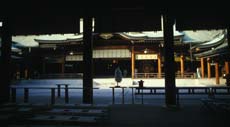Structural complexity

Tourists sitting outside a cafe at Disney's Animal Kingdom park

Meiji Shrine in Tokyo
Place structures include both the spatial and architectural features of the place but also the social grammar that structures what actions are appropriate or not in the place.
A structurally simple place foregrounds itself all at once, or offers linear courses of action composed of relatively independent serial stages with few second-level connections or references among them, or embodies only one form of life composed of roles that don't interact much.
A structurally complex place involves more elaborated presences-and-absences of special features with the non-explicit background of practice and possibility, or offers non-linear trajectories of action and interwoven multiplicities of forms of life with more potential for conflict and tragedy.
Structural complexity does not measure the depth of your or my psychological reactions. The complexity of places lies in the norms and expectations that regulate what actions are possible; these do not have to be always focally present. You have a rich artistic response to the color red; I barely notice colors; but we both stop at red lights because there is a social norm, whose activity is different from the aesthetic impact of the color. The complexity is there (or not) in the norms, in the social definition of the place and its events.